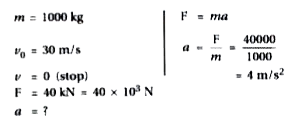A car of mass 1000 kg moves on horizontal road with velocity of 30 m/s. When driver applies brake, constant retarding force of 40 kN is applied, retardation of car will b e .....Solution in Gujrati
2 m/s2
−2m/s2
4 m/s2
−4m/s2
The correct Answer is:D

F=40kN=40×103N
Due to retardatin there will be negative sign
a=−4m/s
Similar Questions
A car of mass 1000 kg is moving with a velocity 20m /s on a horizontal straight road. If the driver applies brakes to produce a constant breaking force of 5000 Newton, the acceleration of the car i s ..... m / s^(2) .
View SolutionA car of mass 1000 kg is moving at a speed 30 m/s. Brakes are applied to bring the car to rest. If the net retardation force is 5000 N, the car comes to stop after travelling d m in t s. Then
View SolutionA car of mass 1000 kg is moving at a speed 30 m/s. Brakes are applied to bring the car to rest. If the net retardation force is 5000 N, the car comes to stop after travelling d m in t s. Then
View SolutionTwo cars A and B are moving in same direction with velocities 30 m/s and 20 m/s. When car A is at a distance d behind the car B, the driver of the car A applies brakes producing uniform retardation of 2m/s2. There will be no collision when :-
View SolutionWhen a car driver travelling at a speed of 10 m/s applies brakes and brings the car to rest in 20 s, then the retardation will be:
View SolutionA car is moving with a velocity of 10 m/s. Suddenly driver sees a child at a distance of 30 m and he applies the brakes, it produced a uniform retardation in car and car stops in 5 second. Find (mass of car=1000 kg) the stopping distance of car will the car hit the child the retardation in car resistive force on car
View SolutionTwo cars A and B are moving in same direction with velocities 30 m/s and 20 m/s. When car A is at a distance d behind the car B, the driver of the car A applies brakes producing uniform retardation of 2m/s2. There will be no collision when :-
View Solution
